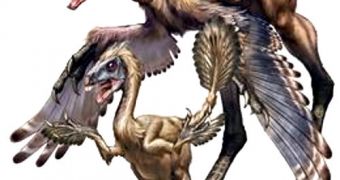Researchers in China announce in a new scientific paper that feathered dinosaurs appeared to have changed their plumage as they got older. According to a team of experts, which analyzed fossils portraying individuals of the same species at various ages, the changes were very obvious and significant, and represented a part of the animals' growth process. Details of their investigation appear in April 28 issue of the esteemed scientific publication Nature.
The research group bases its study on two fossils of Similicaudipteryx dinosaurs, which were members of the egg-stealing family known as oviraptorosaurs. One of the remains is of an animal still in its early adulthood, while the second one belongs to a younger juvenile. The fossils therefore trapped the dinosaurs in a period of their lives when their bodies exhibited massive change. The same holds true in humans, where the transition from childhood to early adulthood promotes the most marked changes and differences.
“This baby dinosaur has bizarre flight feathers, which are strikingly different from those of adults,” explains expert Xing Xu, who is based at the Institute of Vertebrate Paleontology and Paleoanthropology, in Beijing. He was also the first author of the journal entry, Nature News reports. He explains that the maturation pattern this dinosaur species exhibits is no longer encountered in modern birds. The fossilized remains were collected from the Lower Cretaceous Yixian Formation, which is located in the western parts of the Liaoning province. Their age is estimated to be around 125 million years.
The investigation is the first-ever to show a transition from simpler to more complex feathers in dinosaurs. “Modern birds don't make such a transition. This paper marks the first step in attempts to disentangle the evolution of developmental sequences among birds and their ancestors,” says University of Bristol expert Mike Benton. He adds that, in the case of birds, flight feathers remain the same throughout their lives. The only times when feathers look different is while the animal is still in its early infancy, and still sports its downy feathers.

 14 DAY TRIAL //
14 DAY TRIAL //